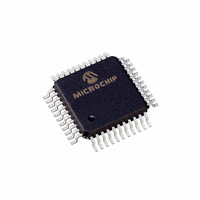PIC16LC774-I/PQ Microchip Technology, PIC16LC774-I/PQ Datasheet - Page 102

PIC16LC774-I/PQ
Manufacturer Part Number
PIC16LC774-I/PQ
Description
44 PIN, 7KB OTP, 256 RAM, 33 I/O,
Manufacturer
Microchip Technology
Series
PIC® 16Cr
Specifications of PIC16LC774-I/PQ
Rohs Compliant
YES
Core Processor
PIC
Core Size
8-Bit
Speed
20MHz
Connectivity
I²C, SPI, UART/USART
Peripherals
Brown-out Detect/Reset, POR, PWM, WDT
Number Of I /o
33
Program Memory Size
7KB (4K x 14)
Program Memory Type
OTP
Ram Size
256 x 8
Voltage - Supply (vcc/vdd)
2.5 V ~ 5.5 V
Data Converters
A/D 10x12b
Oscillator Type
External
Operating Temperature
-40°C ~ 85°C
Package / Case
44-MQFP, 44-PQFP
Processor Series
PIC16LC
Core
PIC
Data Bus Width
8 bit
Data Ram Size
256 B
Interface Type
I2C, SPI, SSP, UART
Maximum Clock Frequency
20 MHz
Number Of Programmable I/os
33
Number Of Timers
3 bit
Operating Supply Voltage
2.5 V to 5.5 V
Maximum Operating Temperature
+ 85 C
Mounting Style
SMD/SMT
3rd Party Development Tools
52715-96, 52716-328, 52717-734
Development Tools By Supplier
ICE2000, DM163022
Minimum Operating Temperature
- 40 C
On-chip Adc
10 bit
Lead Free Status / RoHS Status
Lead free / RoHS Compliant
Eeprom Size
-
Lead Free Status / Rohs Status
Details
Available stocks
Company
Part Number
Manufacturer
Quantity
Price
Company:
Part Number:
PIC16LC774-I/PQ
Manufacturer:
Microchip Technology
Quantity:
10 000
PIC16C77X
9.2
In this mode, the USART uses standard nonreturn-to-
zero (NRZ) format (one start bit, eight or nine data bits
and one stop bit). The most common data format is
8-bits. An on-chip dedicated 8-bit baud rate generator
can be used to derive standard baud rate frequencies
from the oscillator. The USART transmits and receives
the LSb first. The USART’s transmitter and receiver are
functionally independent but use the same data format
and baud rate. The baud rate generator produces a
clock either x16 or x64 of the bit shift rate, depending
on bit BRGH (TXSTA<2>). Parity is not supported by
the hardware, but can be implemented in software (and
stored as the ninth data bit). Asynchronous mode is
stopped during SLEEP.
Asynchronous mode is selected by clearing bit SYNC
(TXSTA<4>).
The USART Asynchronous module consists of the fol-
lowing important elements:
• Baud Rate Generator
• Sampling Circuit
• Asynchronous Transmitter
• Asynchronous Receiver
9.2.1
The USART transmitter block diagram is shown in
Figure
(serial) shift register (TSR). The shift register obtains its
data from the read/write transmit buffer, TXREG. The
TXREG register is loaded with data in software. The
TSR register is not loaded until the STOP bit has been
transmitted from the previous load. As soon as the
STOP bit is transmitted, the TSR is loaded with new
data from the TXREG register (if available). Once the
TXREG register transfers the data to the TSR register
FIGURE 9-3:
DS30275A-page 102
9-3. The heart of the transmitter is the transmit
USART Asynchronous Mode
USART ASYNCHRONOUS TRANSMITTER
TXIE
Interrupt
USART TRANSMIT BLOCK DIAGRAM
TXEN
TXIF
Baud Rate Generator
SPBRG
Baud Rate CLK
MSb
(8)
Advance Information
TX9D
TSR register
TX9
TXREG register
8
Data Bus
(occurs in one T
flag bit TXIF (PIR1<4>) is set. This interrupt can be
enabled/disabled by setting/clearing enable bit TXIE
( PIE1<4>). Flag bit TXIF will be set regardless of the
state of enable bit TXIE and cannot be cleared in soft-
ware. It will reset only when new data is loaded into the
TXREG register. While flag bit TXIF indicated the sta-
tus of the TXREG register, another bit TRMT
(TXSTA<1>) shows the status of the TSR register. Sta-
tus bit TRMT is a read only bit which is set when the
TSR register is empty. No interrupt logic is tied to this
bit, so the user has to poll this bit in order to determine
if the TSR register is empty.
Steps to follow when setting up an Asynchronous
Transmission:
1.
2.
3.
4.
5.
6.
7.
Note 1: The TSR register is not mapped in data
Note 2: Flag bit TXIF is set when enable bit TXEN
Initialize the SPBRG register for the appropriate
baud rate. If a high speed baud rate is desired,
set bit BRGH.
Enable the asynchronous serial port by clearing
bit SYNC and setting bit SPEN.
If interrupts are desired, then set enable bit
TXIE.
If 9-bit transmission is desired, then set transmit
bit TX9.
Enable the transmission by setting bit TXEN,
which will also set bit TXIF.
If 9-bit transmission is selected, the ninth bit
should be loaded in bit TX9D.
Load data to the TXREG register (starts trans-
mission).
LSb
0
memory so it is not available to the user.
is set.
TRMT
CY
), the TXREG register is empty and
(Section
Pin Buffer
and Control
SPEN
1999 Microchip Technology Inc.
9.1)
RC6/TX/CK pin
















